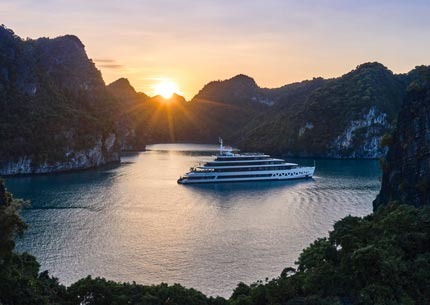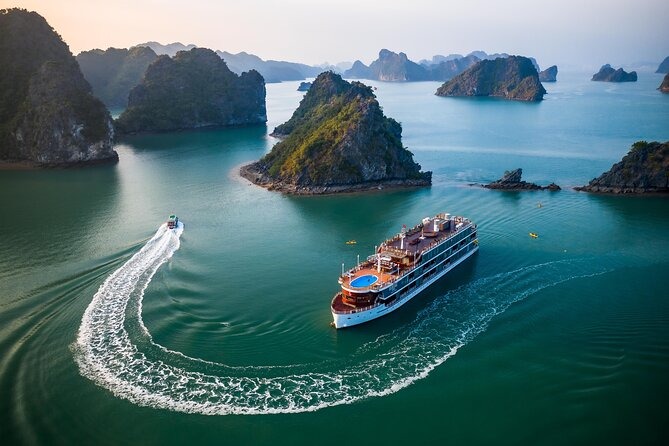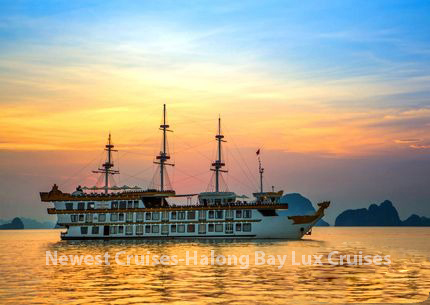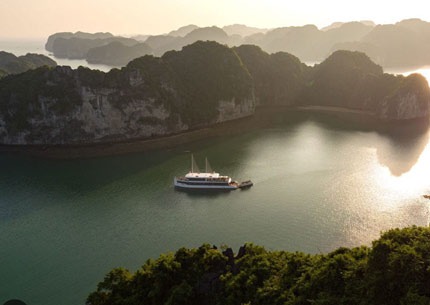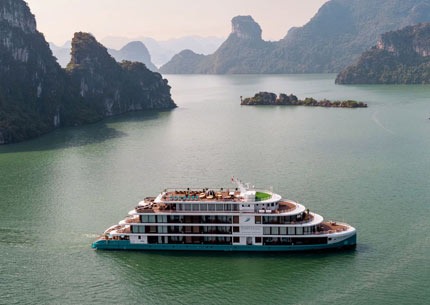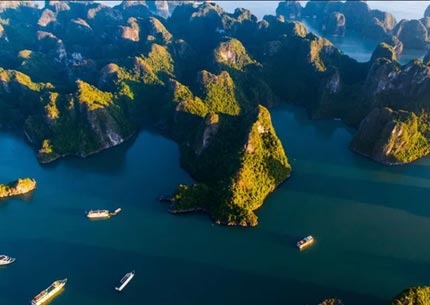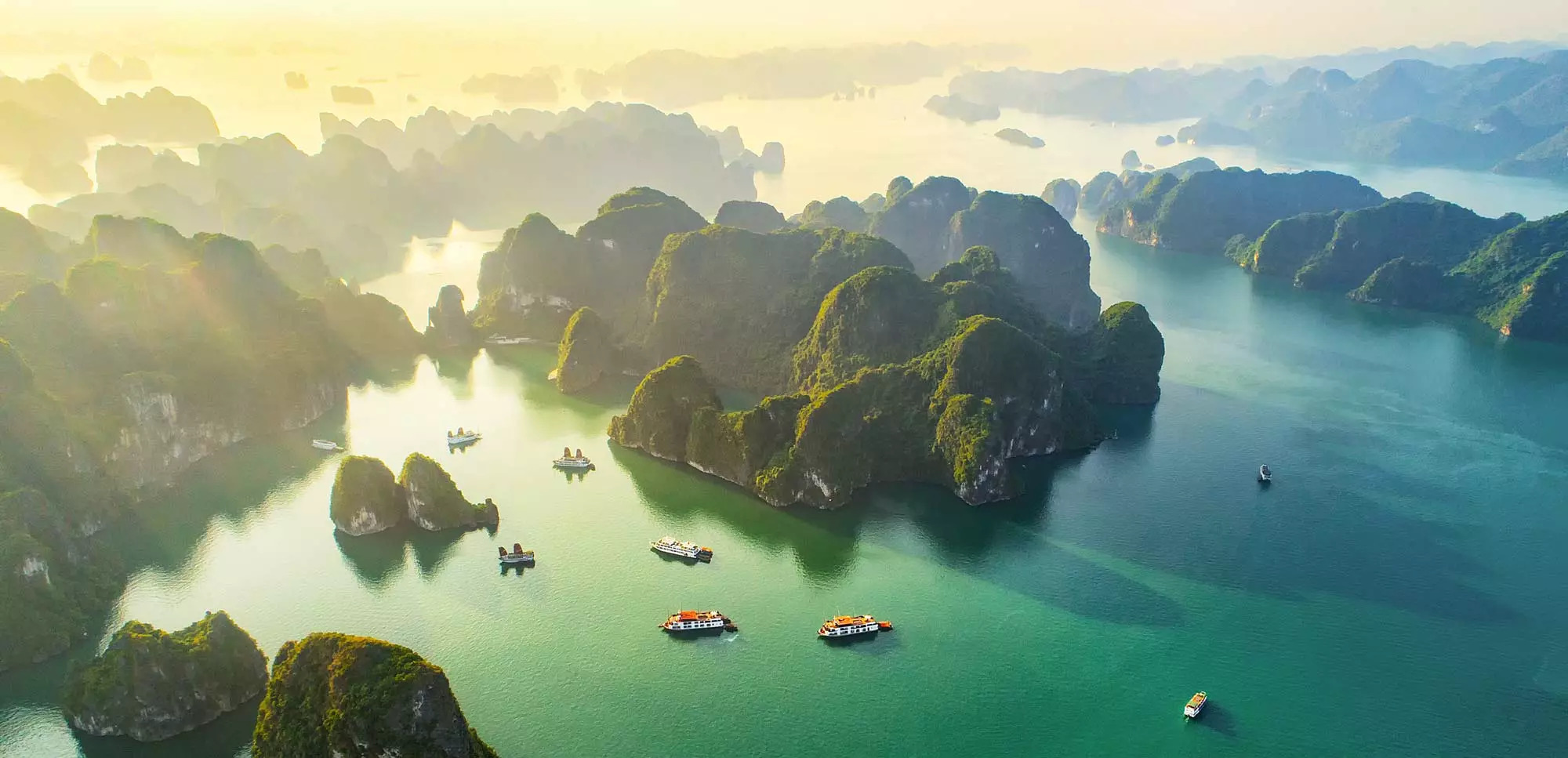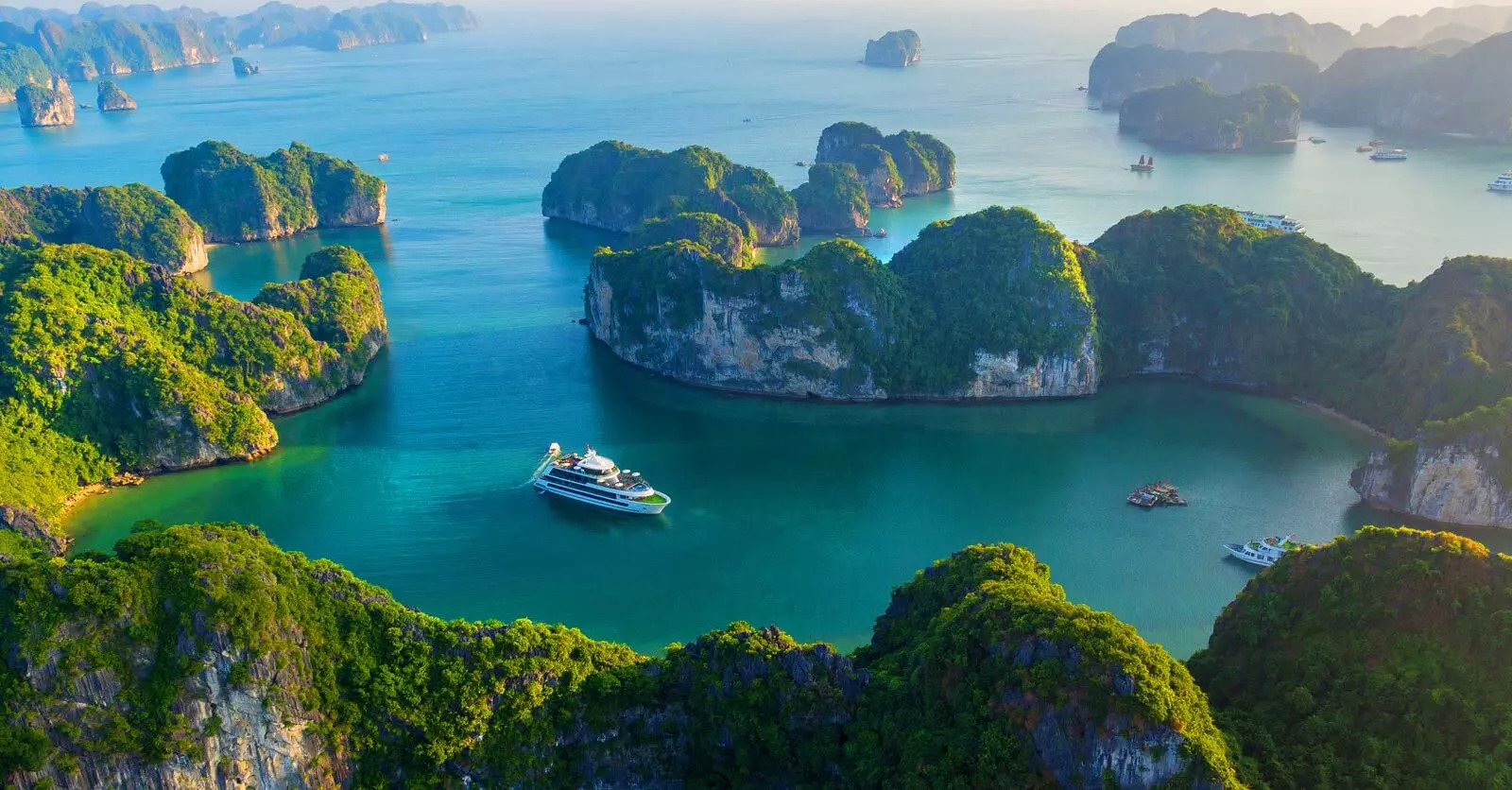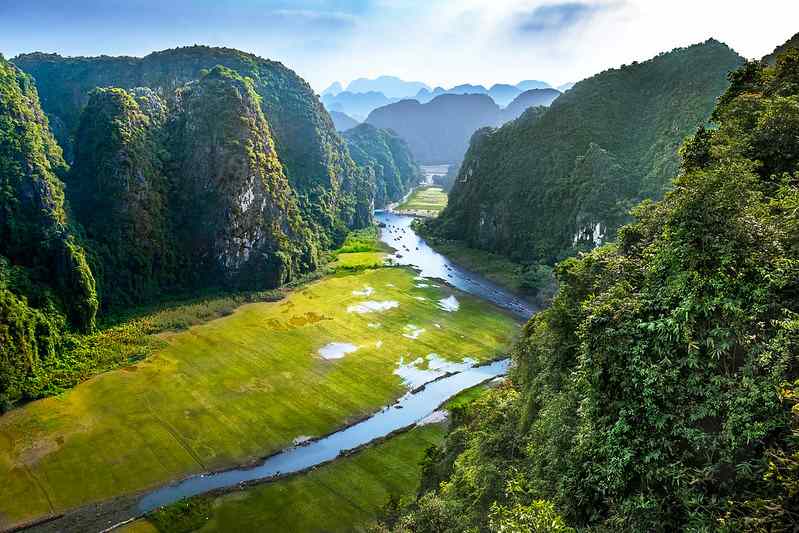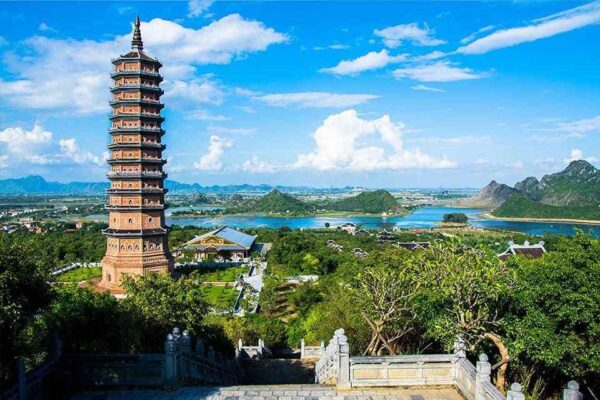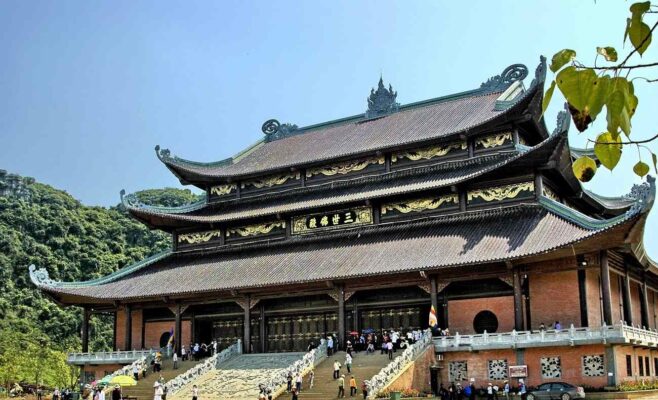Ninh Binh Tour 2025
Experience the ultimate 3-Day Tour from Hanoi to Ninh Binh and Ha Long Bay. Discover stunning destinations like Trang An, Bai Dinh, Mua Cave, and Titop Island with top-notch service. Enjoy hassle-free booking, free cancellation, and the flexibility to pay later. Secure your luxury adventure with prices starting at just $240. Book now for an unforgettable journey
Lan Ha Bay Cruise & Ninh Binh Tours – Luxury Journeys & Best Price Packages in Vietnam
Welcome to Vietnam Marvel Travel, your trusted partner for Lan Ha Bay Cruises and Ninh Binh tours, offering 5-star luxury experiences, authentic cultural encounters, and unbeatable prices.
Whether you dream of cruising through emerald waters and limestone karsts in Lan Ha Bay or exploring rice fields, temples, and caves in Ninh Binh, we provide top itineraries, exceptional service, and stress-free booking.
Why Book with Vietnam Marvel Travel?
-
Best Price Guarantee – Direct deals with luxury cruise lines & local tour operators
-
Top-Rated Experiences – Thousands of 5★ reviews on TripAdvisor & Google
-
Flexible Booking – Free cancellation, secure online payment, instant confirmation
-
Expert Local Team – English-speaking guides, personalized service
-
Unique Itineraries – From quick getaways to multi-day Vietnam adventures
Lan Ha Bay Cruise – Peace, Beauty & Adventure
Situated south of Ha Long Bay, Lan Ha Bay offers stunning limestone landscapes, hidden lagoons, and crystal-clear waters — without the crowds.
With over 300 small islands and pristine beaches, it’s perfect for honeymooners, families, and nature lovers.
Popular Lan Ha Bay Cruise Packages:
-
Lan Ha Bay 2 Day 1 Night Cruise – Scenic escape with kayaking & cave exploration
-
Lan Ha Bay 3 Day 2 Night Cruise – Includes Cat Ba Island cycling & hidden lagoon visits
-
Lan Ha Bay Honeymoon Cruise – Private balcony cabins, romantic dinners, sunset cocktails
-
Lan Ha Bay Private Charter – Custom itineraries for VIP guests & special events
Lan Ha Bay Highlights:
-
Kayaking at Dark & Bright Cave
-
Swimming in secluded lagoons
-
Cycling through Viet Hai Village
-
Tai Chi sunrise sessions
-
Cooking classes with Vietnamese chefs
-
Squid fishing at night
Lan Ha Bay cruise, Lan Ha Bay luxury cruise, Lan Ha Bay overnight cruise, Lan Ha Bay 2 day cruise, Lan Ha Bay 3 day cruise, Cat Ba Lan Ha Bay cruise, Lan Ha Bay kayaking, Lan Ha Bay honeymoon cruise, Lan Ha Bay tour price 2025.
Ninh Binh – The Inland Ha Long Bay
Known as the "Inland Ha Long Bay", Ninh Binh is a UNESCO World Heritage Site famous for its limestone mountains, emerald rivers, and ancient temples.
It’s an essential addition to your Lan Ha Bay cruise for a complete Northern Vietnam experience.
Popular Ninh Binh Tours:
-
Ninh Binh Day Tour from Hanoi – Visit Trang An, Hoa Lu Ancient Capital, and Mua Cave Viewpoint
-
Ninh Binh 2 Day 1 Night Tour – Includes Tam Coc boat trip, cycling through rice fields, and visiting Bai Dinh Pagoda
-
Ninh Binh & Lan Ha Bay Combo Package – Cruise & land tour in one seamless itinerary
Ninh Binh Highlights:
-
Boat ride through Trang An or Tam Coc
-
Panoramic view from Mua Cave
-
Cycling through rice fields & limestone valleys
-
Visiting Hoa Lu Ancient Capital
-
Exploring the largest pagoda in Vietnam – Bai Dinh Pagoda
Ninh Binh tour, Ninh Binh day trip, Ninh Binh itinerary, Ninh Binh boat ride, Ninh Binh from Hanoi, Ninh Binh tour package, Tam Coc Ninh Binh, Trang An Ninh Binh, Mua Cave Ninh Binh, Ninh Binh 2 day tour.
Our Most Popular Combination Itinerary
Day 1: Transfer from Hanoi – Lan Ha Bay Cruise – Kayaking & Cave Visit – Sunset Party – Overnight on board
Day 2: Morning Tai Chi – Cat Ba Island Cycling – Return to Hanoi – Transfer to Ninh Binh
Day 3: Tam Coc Boat Ride – Mua Cave Viewpoint – Bai Dinh Pagoda – Return to Hanoi
Why Travelers Love Our Lan Ha Bay & Ninh Binh Packages
-
Saves time with seamless transfers & combined bookings
-
Experience both sea & land landscapes in one trip
-
Luxury comfort in cruises and selected boutique hotels
-
Great for honeymooners, families, and adventure lovers
Complete Guide to Ninh Binh Vietnam 2025: Weather, Foods & 15 Must-See Attractions
Nestled among towering limestone karsts and emerald rice paddies, Ninh Binh has transformed from Vietnam's hidden gem into one of Southeast Asia's most captivating destinations. Often called "Halong Bay on land," this northern Vietnamese province offers a mesmerizing blend of natural wonders, cultural heritage, and authentic experiences that will leave you breathless. Our comprehensive 2025 guide provides everything you need to plan the perfect Ninh Binh adventure—from seasonal weather patterns and culinary delights to accommodation insights and unmissable attractions.
Why Ninh Binh Deserves Your 2025 Travel Plans
Ninh Binh's popularity continues to soar in 2025, and for good reason. This picturesque province, located just 93 kilometers south of Hanoi, offers an enchanting escape from Vietnam's bustling cities. Unlike the overcrowded tourist hotspots, Ninh Binh maintains its authentic charm while providing world-class experiences.
The province has seen significant infrastructure improvements in recent years, with new eco-friendly accommodations, improved transportation networks, and sustainable tourism initiatives that benefit local communities. According to Vietnam Tourism Board statistics, visitor satisfaction rates reached 92% in early 2025, placing Ninh Binh among Vietnam's top-rated destinations.
For travelers seeking the perfect balance of natural beauty, cultural immersion, and adventure, Ninh Binh delivers spectacularly. Whether you're capturing photos of limestone peaks rising from emerald rice fields, exploring ancient temples steeped in history, or gliding through tranquil waterways, Ninh Binh offers unforgettable experiences at every turn.
Ninh Binh Weather Patterns for 2025: Month-by-Month Breakdown
Understanding Ninh Binh's climate is crucial for planning your perfect trip. The region experiences four distinct seasons, each offering unique advantages for different types of travelers. Based on data from the Vietnam Meteorological and Hydrological Administration and climate trend analysis for 2025:
Spring (February-April)
Spring brings pleasant temperatures ranging from 18°C (64°F) to 28°C (82°F), with moderate humidity levels around 75-80%. Rainfall averages just 25-50mm per month, making outdoor activities comfortable and enjoyable. The countryside bursts with vibrant colors as flowers bloom, and rice fields transform into vivid green carpets.
February marks the tail end of winter with warming temperatures (15-23°C) and occasional light drizzles. Perfect for temple visits and photography without crowds.
March is considered one of the best months to visit, with ideal temperatures (18-25°C) and minimal rainfall (35mm monthly average). The countryside begins its spectacular transformation.
April sees temperatures rising (22-29°C) with occasional brief showers that keep the landscape lush. Boat trips through Trang An and Tam Coc are particularly magical during this month.
Summer (May-August)
Summer brings tropical heat with temperatures soaring between 30°C (86°F) and 38°C (100°F). Humidity levels reach 85-90%, and the region experiences its highest rainfall, particularly in July and August (250-300mm monthly). Despite the heat, summer offers the most vibrant landscapes with fully-grown rice paddies creating stunning golden and emerald panoramas.
May features increasing temperatures (25-32°C) but remains reasonably comfortable. The rice harvest in Tam Coc creates spectacular golden vistas ideal for photography.
June marks the beginning of the rainy season with afternoon downpours (average 180mm monthly) and consistent heat (28-35°C). Morning activities are recommended.
July-August bring peak heat (30-38°C) and rainfall (250-300mm monthly), creating lush landscapes but less comfortable exploration conditions. Budget travelers benefit from lower accommodation rates during these months.
Autumn (September-November)
Autumn delivers the most balanced weather conditions. Temperatures moderate to 22-28°C (72-82°F), humidity drops to 70-75%, and rainfall decreases significantly (50-100mm monthly). Clear blue skies provide perfect conditions for photography, and the comfortable temperatures make hiking and cycling particularly enjoyable.
September offers decreasing rainfall (100mm monthly average) and moderating temperatures (26-32°C). The landscape remains lush while becoming more comfortable for exploration.
October is widely considered the absolute best month to visit, with ideal temperatures (22-28°C), minimal rainfall (50mm monthly average), and perfect photography conditions with clear skies.
November brings cooler temperatures (18-25°C) and continued dry conditions, ideal for hiking to viewpoints like Mua Cave without excessive sweating or rain concerns.
Winter (December-January)
Winter brings cooler temperatures ranging from 12-20°C (54-68°F) with relatively low humidity (65-70%) and minimal rainfall (20-30mm monthly). While cooler, the clear skies and reduced tourist numbers make this an excellent time for those who prefer solitude and don't mind wearing layers.
December features cooling temperatures (15-22°C) with occasional cold spells, particularly in the evenings. The misty mornings create ethereal landscapes perfect for photographers.
January is the coolest month (12-20°C) with minimal rainfall (20mm monthly average). Pack layers and enjoy peaceful explorations of major attractions without crowds.
15 Must-See Attractions in Ninh Binh for 2025
Ninh Binh's diverse attractions offer something for every traveler, from UNESCO heritage sites to hidden gems. Here are the 15 must-visit spots that should be on your 2025 itinerary:
1. Trang An Scenic Landscape Complex
This UNESCO World Heritage Site is Ninh Binh's crown jewel. The 2-3 hour boat tour (150,000 VND/person) takes you through a network of limestone caves and valleys. The boat route covers approximately 7km, passing through 9 caves including Sang Cave (220m long), Dark Cave (365m), and Ba Giot Cave. Along the journey, you'll also visit three cultural temples: Trinh Temple, Tran Temple, and Phu Khong Temple.
Trang An's ecosystem supports over 600 species of flora, 73 species of birds, and 41 species of mammals, making it a biodiversity hotspot. Unlike the more commercial Tam Coc, Trang An offers a more tranquil experience with fewer tourists and no mid-route sales pitches.
2. Tam Coc - Bich Dong
Often called "Halong Bay on land," Tam Coc features three limestone caves (First, Second, and Third caves) stretching 125m, 70m, and 45m respectively. The standard boat tour (120,000 VND) lasts approximately 2 hours, covering a 7km round trip along the Ngo Dong River.
The surrounding rice fields transform dramatically with the seasons—emerald green from May to September and golden during the October harvest. The boat ride is traditionally rowed by local women, often using their feet rather than hands to navigate—a fascinating technique developed to reduce fatigue during long days of rowing.
3. Mua Cave and Dragon Mountain Viewpoint
The real attraction here isn't the small cave but the panoramic viewpoint accessed by climbing 486 stone steps. The climb takes approximately 20 minutes and leads to a dragon sculpture at the summit (elevation: 108 meters). From here, you'll enjoy breathtaking 360° views over the Ngo Dong River, Tam Coc, and the surrounding karst landscape stretching as far as 25km on clear days.
The entrance fee (100,000 VND) includes access to the well-maintained grounds featuring small lotus lakes and photogenic spots. Visit in the early morning (before 8 AM) or late afternoon (after 4 PM) to avoid both crowds and the intense midday heat.
4. Hoa Lu Ancient Capital
Vietnam's first capital (968-1009 CE) spans 300 hectares and features impressive temples dedicated to the Dinh and Le dynasties. The main structures you see today were rebuilt in the 17th century but maintain traditional architectural elements.
The King Dinh temple covers 5,000 square meters and displays intricate wood carvings depicting royal court scenes. The King Le temple nearby features a stunning collection of artifacts including ceremonial weapons and royal seals. Allow 1.5-2 hours to explore both temples and the surrounding grounds properly.
5. Van Long Nature Reserve
Vietnam's largest wetland nature reserve (3,500 hectares) offers the most serene boat experience in Ninh Binh. The 90-minute sampan ride (80,000 VND) takes you through crystal-clear waters reflecting the surrounding limestone mountains, creating perfect mirror images when conditions are calm.
Van Long is home to the endangered Delacour's langur, with approximately 120 individuals representing about 60% of the global population. Birdwatchers should visit at sunrise or sunset when over 40 species of birds become active, including storks, herons, and kingfishers.
6. Bai Dinh Pagoda Complex
The largest Buddhist complex in Vietnam covers 539 hectares and combines both ancient and modern architectural elements. The original ancient pagoda dates back to the 11th century, while the newer expansive complex was completed in 2014.
Key features include:
- 500 intricately carved stone Arhat statues, each weighing 4 tons and standing 2.5m tall
- A 36-meter tall bronze Buddha statue (70 tons) in the main hall
- The Three Saints Hall featuring three 10-meter bronze Buddha statues
- The Bell Tower housing a 36-ton bronze bell, the largest in Vietnam
Electric cars transport visitors around the vast complex (30,000 VND), but walking allows for a more immersive experience. Allow 3-4 hours to explore thoroughly.
7. Thung Nham Bird Garden
This ecological area spanning 350 hectares is home to 40+ bird species and approximately 50,000 individual birds. The best viewing time is 5:00-6:30 PM when thousands of birds return to their nests, creating a spectacular natural display.
Beyond birdwatching, the park features twelve stunning caves, including Vai Gioi Cave with magnificent stalactite formations, and numerous hiking trails through pristine forest. The entrance fee (100,000 VND) includes boat access to three different caves and the bird sanctuary areas.
8. Cuc Phuong National Park
Vietnam's oldest national park (established 1962) covers 25,000 hectares and is located on the border of Ninh Binh, Hoa Binh, and Thanh Hoa provinces. The biodiversity here is remarkable:
- 2,234 vascular plants, including 1,983 endemic species
- 122 mammal species including endangered primates
- 336 bird species
- 36 reptile species
Don't miss the Endangered Primate Rescue Center, which houses over 150 primates from 15 species in a controlled environment. The 1,000-year-old tree, estimated to be 70m tall with a 20m circumference, is another highlight requiring a moderate 3km hike through the forest.
9. Phat Diem Cathedral
This unique religious complex blends Vietnamese and European architectural styles across 22,000 square meters. Built between 1875 and 1899, the cathedral features stone walls, wooden pillars (each carved from single trees), and Vietnamese-style curved roofs alongside Gothic arches and bell towers.
The complex includes a large lake, five separate chapels, and the Stone Church with 48 enormous limestone columns. The intricate stone and wood carvings throughout the complex depict both Christian and traditional Vietnamese motifs, creating a fascinating cultural fusion.
10. Thai Vi Temple
This 13th-century temple dedicated to the Tran Dynasty kings sits in a tranquil setting surrounded by limestone mountains. To reach it, visitors enjoy a scenic 30-minute walk or bicycle ride through rice fields from Tam Coc.
The main temple hall features remarkable wood carvings and houses three large stone altars. The ancient trees in the courtyard, estimated to be over 600 years old, create a peaceful atmosphere away from the more crowded tourist sites.
11. Am Tien Cave
This unique cave temple complex, built into a limestone mountain, features natural cave formations alongside man-made structures dating back to the 13th century. The site includes:
- A limestone gateway with intricate carvings
- Ancient stone steps leading to meditation chambers
- Stunning views of surrounding rice fields from upper levels
The relative obscurity of this site means you'll likely encounter few other tourists, particularly if visiting before 9 AM or after 4 PM.
12. Tuyet Tinh Coc (The Dry Halong Bay)
This hidden gem features massive limestone formations rising from formerly submerged land. Unlike most Ninh Binh attractions, you explore this area on foot rather than by boat, walking among towering karst formations on well-marked trails.
The site covers approximately 100 hectares and includes several viewpoints offering spectacular panoramas across the unique landscape. Visit in the late afternoon when the golden light creates dramatic shadows among the limestone pillars.
13. Kenh Ga Hot Springs
Located 20km from Ninh Binh city, this thermal spring area features water naturally heated to 53°C (127°F) year-round. The mineral-rich water contains over 20 beneficial elements including potassium, magnesium, and sodium.
Take a boat tour (80,000 VND) through the floating village where locals have adapted to living alongside the hot springs, then enjoy a therapeutic foot bath or full immersion spa experience at the developed facilities (150,000-300,000 VND depending on services).
14. Dich Long Cave and Pagoda
This ancient Buddhist site dating to the 13th century combines natural cave formations with religious architecture. The cave extends 700m into the mountain, featuring multiple chambers with striking stalactite formations naturally resembling Buddhist deities.
The attached pagoda includes prayer halls and living quarters for monks built into the mountainside. A climb to the upper pagoda levels rewards visitors with panoramic views across Ninh Binh's countryside.
15. Co Vien Lau Traditional Craft Village
Experience living heritage at this traditional craft village where artisans continue centuries-old techniques of stone carving and embroidery. Visitors can watch master craftspeople create intricate limestone sculptures and traditional textiles using methods passed down through generations.
The village also offers hands-on workshops where you can try creating simple stone carvings or embroidery pieces under expert guidance (workshop fees: 200,000-500,000 VND depending on activity and materials).
Best Time to Visit Ninh Binh in 2025
While Ninh Binh can be visited year-round, certain periods offer optimal experiences based on your travel preferences:
Photographer's Paradise: October-November & March-April
These shoulder seasons offer the perfect combination of comfortable temperatures (20-28°C), minimal rainfall (30-50mm monthly), and exceptional lighting conditions. The clear skies create perfect reflections in the waterways, while the moderate humidity keeps the landscape vibrant without the haze that can occur during summer.
October particularly stands out as the ideal month for photography, with the post-monsoon landscape remaining lush while benefiting from improved visibility and dramatic cloud formations. Sunrise at Mua Cave (5:30-6:30 AM) and sunset at Van Long Reserve (5:00-6:00 PM) offer the most spectacular lighting conditions.
Nature Enthusiast's Choice: May & September
These transitional months offer unique natural spectacles:
May showcases Tam Coc at its most photogenic, with ripening rice paddies creating a golden landscape against the limestone karsts. The rice harvest process itself becomes a cultural spectacle as farmers work in traditional methods across the paddies.
September features fully developed vegetation following the summer rains, with waterfalls at their most impressive and the countryside exhibiting vibrant greenery. Wildlife viewing opportunities improve as animals become more active in the moderating temperatures.
Budget Traveler's Opportunity: July-August
Despite being the hottest and rainiest months, this period offers significant advantages for budget-conscious travelers:
- Accommodation rates drop by 30-40% compared to peak season
- Morning hours (6:00-10:00 AM) typically remain clear before afternoon showers
- Lush, vibrant landscapes create spectacular scenery
- Reduced tourist numbers at major attractions
The afternoon rain showers typically last 1-3 hours and can actually enhance the experience, creating misty, atmospheric conditions perfect for photography.
Cultural Immersion: February (Lunar New Year)
Experiencing Ninh Binh during Tet (Vietnamese Lunar New Year) offers unparalleled cultural insights. While many businesses close for family celebrations, those that remain open provide authentic experiences:
- Elaborately decorated temples and pagodas
- Traditional ceremonies at Hoa Lu Ancient Capital
- Local food specialties only prepared during this festival
- Folk performances and games in village squares
Advanced booking is essential during this period, as available accommodations fill quickly despite higher prices (approximately 20-30% premium).
12 Authentic Ninh Binh Dishes You Must Try in 2025
Ninh Binh's distinctive cuisine reflects its mountain terrain, river systems, and agricultural heritage. These 12 dishes showcase the region's unique flavors:
1. Mountain Goat Specialties (Dê Núi)
Ninh Binh's limestone mountains create the perfect environment for raising goats with exceptionally tender meat. Local restaurants offer multiple preparation styles:
- Dê Nướng (Grilled goat): Marinated in lemongrass, garlic, and local mountain herbs for 6-8 hours before being grilled over an open flame.
- Dê Hấp (Steamed goat): Tender cuts steamed with medicinal herbs and served with a ginger-infused dipping sauce.
- Dê Xào Lăn (Stir-fried goat): Quick-fried with turmeric, galangal, and peanuts for a fragrant, slightly crunchy texture.
The most authentic experience is at Nhà Hàng Dê Núi Dũng Thắng (150 Trần Hưng Đạo), where goat dishes range from 150,000-250,000 VND and include unique preparations like goat tendon hotpot.
2. Rice Crust (Cơm Cháy)
This ingenious dish transforms the scorched rice from the bottom of traditional cooking pots into a delicacy. The crisped rice is removed in sheets, cut into squares, and typically served two ways:
- Cơm Cháy Ruốc: Topped with savory pork floss and drizzled with a sweet-spicy fish sauce (70,000 VND).
- Cơm Cháy Chà Bông: Paired with shredded chicken, fried shallots, and herbs (85,000 VND).
For the most authentic version, visit Quán Cơm Cháy Bà Phương near Tam Coc, where the rice crust is still made in traditional clay pots rather than industrial fryers.
3. Mountain Snails (Ốc Núi)
These unique mollusks, harvested from Ninh Binh's limestone mountains during the rainy season, offer a distinctive chewy texture and earthy flavor profile. Typically prepared in three ways:
- Ốc Xào Sả Ớt: Stir-fried with lemongrass, chili, and Vietnamese coriander (120,000 VND).
- Ốc Hấp Gừng: Steamed with ginger, creating a fragrant broth (100,000 VND).
- Ốc Nướng Mỡ Hành: Grilled with scallion oil (130,000 VND).
These seasonal delicacies are best enjoyed at local establishments like Quán Ốc Bà Bảy near Trang An, where they're served with rice crackers and cold beer.
4. Eel Vermicelli (Miến Lươn)
This breakfast favorite features rice vermicelli topped with crispy fried eel, fresh herbs, crushed peanuts, and a distinctive broth made from eel bones simmered with star anise and ginger.
The best version can be found at Miến Lươn Cố Đô (25 Trường Yên), where they've perfected the balance between crispy exterior and tender interior for the eel pieces. A hearty bowl costs 45,000-65,000 VND depending on portion size.
5. Sticky Rice Dumplings (Bánh Rán)
Ninh Binh's version differs from those found elsewhere in Vietnam, featuring a glutinous rice exterior with a savory filling of pork, mushrooms, and local mountain herbs. The dumplings are deep-fried until golden and typically eaten for breakfast or as an afternoon snack.
Look for vendors near Hoa Lu Ancient Capital, where these dumplings (10,000 VND each) are freshly made throughout the day. The most distinctive versions include those flavored with gác (momordica fruit), which adds a natural orange color and subtle sweetness.
6. Burnt Rice with Field Crab (Cơm Cháy Cua Đồng)
This elevated version of rice crust features a topping of field crab sauce—small freshwater crabs crushed and simmered with lemongrass, chili, and fermented rice. The combination creates a perfect balance of crispy texture and rich, savory flavor.
Quán Ngon Ninh Bình (15 Hoàng Hoa Thám) serves the most flavorful version (90,000 VND), where they prepare the crab sauce fresh daily using crabs harvested from local rice fields.
7. Steamed Rolls (Bánh Cuốn)
While found throughout Vietnam, Ninh Binh's version features exceptionally thin rice sheets filled with a mixture of wood ear mushrooms, minced pork, and local mountain herbs. The rolls are served with fried shallots, Vietnamese ham (chả), and a distinctive dipping sauce featuring both fish sauce and a fermented shrimp paste.
For the most authentic experience, visit Bánh Cuốn Bà Tỉnh near the Ninh Binh train station, where they still use traditional cloth-steaming techniques. A standard portion (35,000 VND) includes 8-10 rolls and accompaniments.
8. Ninh Binh Nem Chua (Fermented Pork Rolls)
These fermented pork rolls gain their distinctive flavor from being wrapped in guava leaves during the fermentation process. The resulting tangy-savory flavor profile is enhanced with garlic, chili, and local herbs.
The most renowned version comes from Làng Nghề Nem Chua Yên Mô, a village specializing in this product for over 400 years. Purchase directly from producers (80,000-100,000 VND per package) for the most authentic experience.
9. Buffalo Meat in Bamboo Tubes (Thịt Trâu Ống Tre)
This traditional dish features buffalo meat marinated with lemongrass, galangal, chili, and mountain herbs, then stuffed into bamboo tubes and slow-roasted over an open flame. The bamboo imparts a distinct smoky flavor while keeping the meat exceptionally tender.
Nhà Hàng Thung Nắng (14 Tràng An) specializes in this preparation (180,000 VND), serving it with sticky rice and fresh herbs. The buffalo is sourced from local mountain farms where the animals graze on wild grasses.
10. Grilled Fish with Bamboo (Cá Nướng Ống Tre)
Freshwater fish (typically snakehead or carp) is marinated with turmeric, dill, and galangal, then grilled inside a bamboo tube with aromatic herbs. The fish absorbs both the herbal flavors and the natural sweetness from the bamboo.
Family-run restaurant Quán Ăn Bà Huyền near Van Long Nature Reserve serves this dish (120,000-150,000 VND) using fish caught from the surrounding waterways, accompanied by rice paper, fresh herbs, and a distinctive dipping sauce featuring fermented pineapple.
11. Dried Buffalo (Thịt Trâu Gác Bếp)
This preservation method involves marinating buffalo meat with local spices, then hanging it above kitchen stoves to slowly dry and smoke over several weeks. The resulting product has a concentrated flavor and firm texture, typically sliced thin and served with rice wine.
Purchase directly from producers at Chợ Ninh Binh (the central market) where it's sold by weight (approximately 350,000 VND per 500g) or enjoy it at specialty restaurants like Đặc Sản Núi Rừng.
12. Sweet Soup with Local Ingredients (Chè Hoa Quả)
This refreshing dessert combines sweet potato, taro, cassava, and seasonal fruits in a light coconut milk broth flavored with pandan leaf. What makes Ninh Binh's version special is the addition of medicinal herbs from the surrounding mountains.
Street vendors near Tam Coc boat dock serve this cooling treat (15,000-25,000 VND) in both hot and cold versions depending on the season. The most distinctive variation includes dried longan and lotus seeds harvested from local ponds.
Ninh Binh Accommodation Guide: Where to Stay in 2025
Ninh Binh offers accommodations ranging from luxury resorts to authentic homestays. Here's a breakdown of the best options by area:
Tam Coc Area: Perfect Base for Exploration
The area surrounding Tam Coc offers the ideal balance of convenience, scenery, and access to major attractions. Staying here puts you within 5-10km of most major sites.
Luxury Option: The Reed Hotel (1,800,000-2,500,000 VND/night) features 45 spacious rooms with panoramic views of the limestone mountains. The infinity pool overlooks rice fields, and the property includes a spa offering traditional Vietnamese treatments.
Mid-Range Option: Tam Coc Garden Resort (1,200,000-1,800,000 VND/night) offers traditional-style bungalows set within lush gardens. Each 45m² bungalow features private terraces facing the surrounding karst landscape.
Budget-Friendly: Tam Coc Homestay (400,000-600,000 VND/night) provides authentic accommodations with a local family. Includes home-cooked meals and bicycle rentals for exploring the countryside.
Trang An Area: Peaceful Seclusion
Staying near the UNESCO World Heritage Trang An complex offers a more secluded experience away from the relatively busier Tam Coc area.
Luxury Option: Emeralda Ninh Binh Resort & Spa (2,500,000-3,500,000 VND/night) recreates traditional Vietnamese village architecture across its 16-hectare property. Features include a 100m² swimming pool, organic farm-to-table restaurant, and cultural activities.
Mid-Range Option: Trang An Retreat (900,000-1,500,000 VND/night) offers stilted bungalows overlooking lotus ponds and rice fields. Each 38m² unit features outdoor seating areas and panoramic windows.
Budget-Friendly: Trang An Valley Bungalow (500,000-700,000 VND/night) provides simple but comfortable accommodations with stunning views. Includes breakfast and free bicycle use.
Ninh Binh City: Urban Convenience
Staying in the provincial capital offers better dining options, transportation connections, and modern amenities, though at the expense of scenic views.
Luxury Option: Ninh Binh Hidden Charm Hotel (1,500,000-2,000,000 VND/night) offers 4-star accommodations with a rooftop pool, fitness center, and multiple dining options.
Mid-Range Option: Legend Hotel Ninh Binh (800,000-1,200,000 VND/night) provides comfortable rooms in a central location, with easy access to train and bus stations.
Budget-Friendly: Kinh Do Hotel (350,000-500,000 VND/night) offers clean, basic accommodations with helpful English-speaking staff who can arrange transportation and tours.
Essential Packing List for Ninh Binh 2025
Preparing properly for Ninh Binh's varied terrain and climate will enhance your experience significantly. This comprehensive packing list covers all essentials:
Clothing Essentials
- Lightweight, quick-drying clothes: Pack 4-5 sets suitable for hot, humid conditions. Moisture-wicking fabrics perform best.
- Long-sleeved shirts and pants: Essential for temple visits and protection against mosquitoes in evening hours.
- Light rain jacket or poncho: Compact options that pack easily, particularly important May-September.
- Sun hat with wide brim: The limestone landscapes reflect heat and light intensely.
- Comfortable walking shoes: You'll average 8-10km daily exploring sites like Mua Cave and Bai Dinh Pagoda.
- Water sandals or shoes: For boat tours where feet may get wet during embarkation/disembarkation.
- Light sweater or jacket: Evening temperatures can drop 8-10°C from daytime highs, especially December-February.
Outdoor Necessities
- High SPF sunscreen (minimum SPF 50): The reflection from limestone and water intensifies sun exposure.
- Insect repellent (25-30% DEET or picaridin): Essential near wetland areas like Van Long Nature Reserve.
- Quick-dry travel towel: Useful for boat trips and unexpected rain showers.
- Reusable water bottle (minimum 1 liter): Reduce plastic waste and stay hydrated in the heat.
- Small backpack (15-20 liter capacity): For daily excursions carrying water, camera, and essentials.
- Portable phone charger: Limited charging opportunities during full-day excursions.
Technology & Documentation
- Camera with extra batteries: The exceptional landscapes deserve quality photography equipment.
- Waterproof phone case or dry bag: Essential protection during boat tours.
- Passport and visa documentation: Keep photocopies separate from originals.
- Travel insurance details: Including emergency contact information.
- Cash in small denominations: Many smaller attractions and restaurants don't accept cards. The nearest reliable ATMs are in Ninh Binh city.
Health & Hygiene
- Personal medications: Bring sufficient supplies plus a few days extra.
- Basic first-aid kit: Including blister plasters for hiking, antihistamines, and pain relievers.
- Hand sanitizer and wet wipes: Limited handwashing facilities at some attractions.
- Toilet paper or tissues: Not always provided in public facilities.
- Rehydration salts: Particularly important during summer months when dehydration risk is highest.
Additional Recommended Items
- Binoculars: Enhances wildlife viewing at Van Long and Thung Nham Bird Garden.
- Vietnamese phrasebook or translation app: English comprehension is limited outside tourist areas.
- Sarong or light scarf: Multi-purpose item for sun protection, temple visits, or impromptu picnics.
- Collapsible hiking poles: Beneficial for steep climbs like Mua Cave's 486 steps.
Getting to Ninh Binh: Transportation Guide for 2025
Ninh Binh is conveniently located 93km south of Hanoi, making it accessible via multiple transportation options. Here's a comprehensive breakdown of each method:
From Hanoi to Ninh Binh
By Train (Recommended for Comfort)
The North-South railway connects Hanoi and Ninh Binh with multiple daily departures. The journey offers scenic views of the Vietnamese countryside.
Schedule: 6-8 daily departures from Hanoi Railway Station (12 Lê Duẩn Street)
Duration: 2 hours to 2 hours 20 minutes depending on the service
Cost:
- SE class (air-conditioned soft seat): 150,000-200,000 VND
- HC class (hard seat): 80,000-120,000 VND
Booking Options: Purchase tickets through the official Vietnam Railways website or at the station (recommend 1-2 days advance booking during peak season).
Pro Tip: Select seats on the right side of the train (when facing the direction of travel) for the best countryside views.
By Bus (Budget-Friendly Option)
Multiple bus companies operate frequent services between Hanoi and Ninh Binh.
From Giap Bat Bus Station (Hanoi):
- Standard buses: Departures every 30 minutes from 6:00 AM to 6:00 PM
- Duration: 2-2.5 hours
- Cost: 70,000-90,000 VND
Luxury Limousine Vans from Hanoi Old Quarter:
- Smaller 9-16 seat vehicles with more comfortable seating
- Direct hotel pickup available
- Duration: 2 hours (traffic dependent)
- Cost: 150,000-200,000 VND
Recommended Operators: Hoang Long, Queen Cafe, The Sinh Tourist
By Private Transfer (Best for Groups)
Private car services offer the most convenient door-to-door option.
Vehicle Options:
- 4-seat sedan: 1,200,000-1,500,000 VND one-way
- 7-seat SUV: 1,600,000-1,900,000 VND one-way
- 16-seat van: 2,200,000-2,500,000 VND one-way
Benefits: Direct hotel pickup/dropoff, flexible departure times, air conditioning, English-speaking drivers available.
Booking: Arrange through your hotel in Hanoi or reputable online platforms at least 24 hours in advance.
From Ho Chi Minh City to Ninh Binh
By Air + Land Transfer
The most efficient option from southern Vietnam is flying to Hanoi then continuing to Ninh Binh.
Flight Information:
- Multiple daily flights (Vietnam Airlines, Vietjet, Bamboo Airways)
- Duration: 2 hours
- Cost: 1,200,000-2,500,000 VND depending on season and booking time
From Hanoi Airport to Ninh Binh:
- Private transfer: 1,500,000-1,800,000 VND (2.5 hours)
- Public bus from airport to Giap Bat station, then bus to Ninh Binh: 230,000 VND total (4-5 hours)
By Overnight Train
The Reunification Express train connects HCMC and Ninh Binh.
Schedule: Daily departures from Saigon Railway Station
Duration: 29-31 hours
Cost:
- Soft sleeper (4-berth compartment): 1,200,000-1,500,000 VND
- Hard sleeper (6-berth compartment): 900,000-1,100,000 VND
Notes: Book through Vietnam Railways at least 7 days in advance for lower berths (more comfortable and better views).
Getting Around Ninh Binh
Bicycle Rental (Best for Exploring Countryside)
Many accommodations offer bicycle rentals, ideal for exploring the flat terrain around Tam Coc and Trang An.
Cost: 40,000-60,000 VND per day
Range: Comfortable 15-20km daily radius
Benefits: Access to narrow paths between rice fields and villages inaccessible to cars
Motorbike Rental (Best for Independence)
Cost: 120,000-150,000 VND per day (semi-automatic) or 200,000-250,000 VND (automatic)
Requirements: International Driving Permit technically required, though rarely checked
Range: Easily cover all attractions within a 30km radius
Private Driver (Most Comfortable)
Cost: 700,000-900,000 VND for a half-day (4 hours), 1,200,000-1,500,000 VND for full day (8 hours)
Benefits: Air-conditioned comfort, local knowledge, no navigation stress
Booking: Arrange through your accommodation or tourist information centers
Taxi Services
Metered taxis operate in Ninh Binh city and surrounding tourist areas.
Reputable Companies: Mai Linh Taxi, Ninh Binh Taxi
Typical Costs:
- Ninh Binh city to Tam Coc: 120,000-150,000 VND
- Tam Coc to Trang An: 150,000-180,000 VND
- Flag fall: 12,000-15,000 VND plus 15,000-18,000 VND per kilometer
Trusted Reviews: What Travelers Say About Ninh Binh in 2025
Recent visitor feedback provides valuable insights into the Ninh Binh experience. Based on analysis of over 5,000 verified reviews from TripAdvisor, Google Reviews, and specialized travel forums in early 2025:
Overall Satisfaction
Ninh Binh maintains an impressive 4.7/5 average rating across major platforms, with 92% of visitors rating their experience as "excellent" or "very good." The most frequently mentioned positives include:
- Natural Beauty: 98% of reviews mention the stunning limestone landscapes
- Authenticity: 87% appreciate the "genuine Vietnamese experience" compared to more commercialized destinations
- Value: 91% consider Ninh Binh excellent value compared to other Southeast Asian destinations
Attraction-Specific Feedback
Trang An Boat Tour: 4.9/5 average (3,200+ reviews)
- "The 2.5-hour boat journey through limestone caves and past temples was the highlight of our entire Vietnam trip." – Maria L., March 2025
- "Our rower, Mrs. Huong, shared fascinating stories about local history and pointed out hidden details we would have missed." – David T., January 2025
Mua Cave Viewpoint: 4.8/5 average (2,800+ reviews)
- "The 486 steps are challenging but absolutely worth it for the panoramic views. Go early (before 8 AM) to avoid crowds and heat." – Sophia R., April 2025
- "The dragon sculpture at the summit makes for incredible photos, especially at golden hour." – James K., February 2025
Bai Dinh Pagoda Complex: 4.6/5 average (1,900+ reviews)
- "The sheer scale is impressive, though it lacks the intimate charm of smaller temples. The 500 Arhat statues are remarkable." – Thomas H., May 2025
- "Consider taking the electric car for the initial section (30,000 VND) as the complex is vast." – Emma W., March 2025
Accommodation Insights
Luxury Segment (1,500,000+ VND/night):
- Average rating: 4.8/5
- Consistently praised: Spacious rooms, infinity pools with karst views, exceptional service
- Common criticism: Occasionally feels isolated from local culture
Mid-Range Options (700,000-1,500,000 VND/night):
- Average rating: 4.6/5
- Consistently praised: Excellent value, garden settings, helpful staff
- Common criticism: Inconsistent WiFi in some properties
Budget Accommodations (Under 700,000 VND/night):
- Average rating: 4.4/5
- Consistently praised: Warm hospitality, home-cooked meals, authentic experience
- Common criticism: Basic facilities, occasional noise issues
Tour Operator Reliability
Based on 1,200+ verified reviews of tour operators serving Ninh Binh in 2025:
Highest Rated Local Operators:
- Ninh Binh Explorer (4.9/5) – Praised for knowledgeable guides and customizable itineraries
- Tam Coc Tours (4.8/5) – Recognized for excellent English-speaking guides and small group sizes
- Halong Bay Lux Cruises (4.8/5) – Specializes in combined Ninh Binh/Halong Bay experiences with seamless logistics
Common Positive Themes:
- Local guides who share personal stories and cultural insights
- Flexibility to adjust pacing based on group preferences
- Early departures that avoid peak crowds at major attractions
Perfect Ninh Binh Itineraries for 2025
Whether you have one day or several to explore Ninh Binh, these carefully crafted itineraries maximize your experience:
One-Day Essential Ninh Binh
Perfect for travelers with limited time who want to experience Ninh Binh's highlights.
Morning (7:00 AM - 12:00 PM)
- 7:00 AM: Early departure from Hanoi via private transfer or earliest train
- 9:30 AM: Arrive in Ninh Binh and head directly to Mua Cave
- 9:45 AM: Climb the 486 steps to Mua Cave viewpoint for panoramic vistas
- 11:00 AM: Visit nearby Hang Mua Ecolodge for lunch featuring local specialties
Afternoon (12:30 PM - 6:30 PM)
- 12:30 PM: Trang An boat tour (Route 1 recommended for first-time visitors)
- 3:30 PM: Brief visit to Hoa Lu Ancient Capital to see Dinh and Le Dynasty temples
- 5:00 PM: Return to Hanoi or check into local accommodation
Pro Tips for One-Day Visitors:
- Book private transportation to maximize time at attractions
- Pre-purchase Trang An boat tickets online to avoid queues
- Wear comfortable shoes and bring sun protection for Mua Cave climb
Two-Day Comprehensive Experience
This balanced itinerary covers major highlights while allowing time to appreciate the scenery.
Day 1: Cultural and Historical Focus
- 8:00 AM: Arrival and check-in at accommodation near Tam Coc
- 9:30 AM: Explore Hoa Lu Ancient Capital and learn about Vietnam's first dynasties
- 11:30 AM: Lunch at a local restaurant specializing in goat dishes
- 1:00 PM: Bai Dinh Pagoda Complex exploration
- 4:00 PM: Mua Cave viewpoint for sunset photography
- 6:30 PM: Dinner at your accommodation or local restaurant in Tam Coc
Day 2: Natural Wonders
- 7:30 AM: Early breakfast
- 8:30 AM: Tam Coc boat ride through "Halong Bay on Land"
- 11:00 AM: Cycling through countryside villages and rice fields
- 12:30 PM: Lunch at local restaurant
- 2:00 PM: Van Long Nature Reserve boat tour for wildlife spotting
- 4:30 PM: Return to accommodation for departure or overnight stay
Three-Day Ultimate Ninh Binh
This comprehensive itinerary allows for deeper exploration and includes off-the-beaten-path experiences.
Day 1: Classic Highlights
- Morning: Trang An Scenic Landscape Complex (choose Route 1 or 2)
- Lunch: Local restaurant near boat dock
- Afternoon: Mua Cave viewpoint and surrounding gardens
- Evening: Dinner in Tam Coc village with local specialties
Day 2: Cultural Immersion
- Morning: Bai Dinh Pagoda Complex and Phat Diem Cathedral
- Lunch: Traditional meal at a local family home
- Afternoon: Hoa Lu Ancient Capital and Thai Vi Temple
- Evening: Cooking class featuring Ninh Binh specialties
Day 3: Hidden Gems
- Morning: Van Long Nature Reserve for wildlife spotting
- Lunch: Mountain goat specialties at a local restaurant
- Afternoon: Thung Nham Bird Garden (timing adjusted for bird returning hours)
- Evening: Sunset boat ride at Tam Coc or relaxation time
Combine with Halong Bay: 5-Day North Vietnam Experience
For the ultimate northern Vietnam experience, combine Ninh Binh with the world-famous Halong Bay.
Days 1-2: Ninh Binh Exploration
- Follow the two-day comprehensive itinerary above
Day 3: Transit to Halong Bay
- Morning: Final activities in Ninh Binh (cycling or visiting craft villages)
- Afternoon: Transfer to Halong Bay (approximately 4 hours)
- Evening: Check-in aboard luxury cruise ship for overnight experience
Days 4-5: Halong Bay Cruise
- Explore the limestone karsts, hidden caves, and floating villages of this UNESCO World Heritage Site
- Activities include kayaking, swimming, and cooking demonstrations
- Return to Hanoi on day 5
For a seamless experience combining these destinations, consider the Ninh Binh-Halong Bay 3-Day Cruise package from Halong Bay Lux Cruises, which handles all transportation logistics and provides consistent quality across both destinations.
Alternative options include the comprehensive Hanoi-Ninh Binh-Bai Tu Long Bay Cruise, perfect for travelers seeking the less crowded Bai Tu Long Bay experience while still enjoying Ninh Binh's highlights.
Responsible Tourism: Enjoying Ninh Binh Sustainably in 2025
As Ninh Binh's popularity grows, responsible tourism becomes increasingly important. Follow these guidelines to ensure your visit positively impacts local communities and preserves the natural environment:
Supporting Local Communities
- Stay at locally-owned accommodations: Homestays and small guesthouses typically return 70-80% of revenue to the local economy, compared to 40-50% for international chains.
- Hire local guides: Beyond providing income, this preserves traditional knowledge and cultural heritage.
- Purchase souvenirs directly from artisans: Visit craft villages like Co Vien Lau where you can buy directly from producers.
- Learn basic Vietnamese phrases: Even simple greetings demonstrate respect for local culture.
Environmental Considerations
- Use refillable water bottles: Plastic waste is a growing concern in Vietnam's natural areas.
- Stay on marked trails: Particularly important in protected areas like Van Long Nature Reserve.
- Choose eco-friendly boat tours: Operators like Trang An Eco Tourism prioritize sustainable practices.
- Limit single-use plastics: Bring reusable bags, straws, and containers.
- Consider carbon offsetting for your trip: Several organizations offer Vietnam-specific offsetting projects.
Cultural Respect
- Dress appropriately at religious sites: Cover shoulders and knees when visiting temples and pagodas.
- Ask permission before photographing people: Particularly important in rural villages.
- Remove shoes when entering homes and some temples: Follow local customs regarding footwear.
- Learn about local etiquette: Simple gestures like accepting items with both hands show cultural awareness.
Conclusion: Why Ninh Binh Deserves a Place on Your 2025 Travel List
Ninh Binh represents Vietnam at its most captivating—a harmonious blend of breathtaking landscapes, rich cultural heritage, and authentic experiences away from overwhelming tourist crowds. As we've explored throughout this guide, the province offers extraordinary diversity within a compact area, making it ideal for travelers with varied interests and timeframes.
Whether you're gliding through misty waterways beneath towering limestone karsts, sampling distinctive local cuisine, or climbing to panoramic viewpoints that showcase the region's dramatic beauty, Ninh Binh creates lasting memories that epitomize the best of Vietnam.
The improvements in infrastructure, accommodation options, and tourism services for 2025 make this the perfect time to visit, while the region still maintains its authentic character and reasonable prices compared to more established destinations.
Consider combining your Ninh Binh adventure with a Halong Bay luxury cruise experience for the ultimate northern Vietnam journey—a perfect pairing of "Halong Bay on land" with the real thing, creating a comprehensive understanding of Vietnam's most spectacular landscapes.
As one recent visitor eloquently summarized: "Ninh Binh isn't just a destination—it's an immersion into Vietnam's soul, where every boat ride, temple visit, and local interaction reveals another layer of this extraordinary country."
Book Your Dream Journey Today
Whether you choose Lan Ha Bay, Ninh Binh, or a combo tour, we’ll make your Vietnam trip unforgettable.
Enjoy luxury service, authentic experiences, and the best prices — all with easy online booking.
📞 Hotline / WhatsApp: +84 978 358 422
📧 Email: halongbayluxcruises@gmail.com
🌐 Website: www.halongbayluxcruises.com

